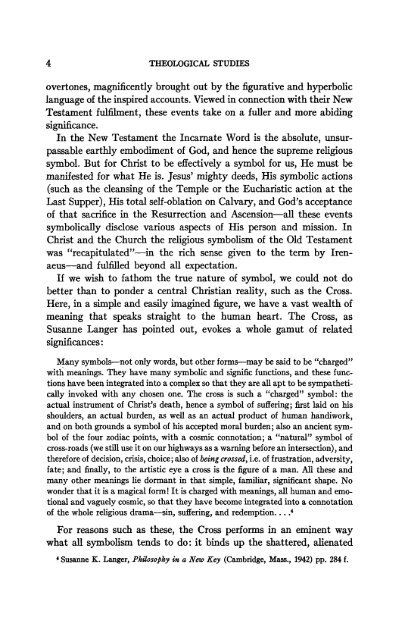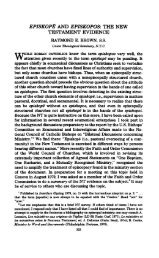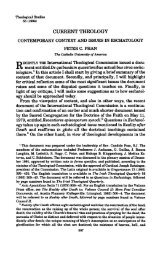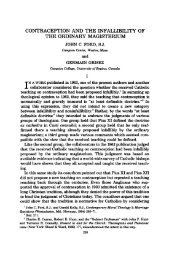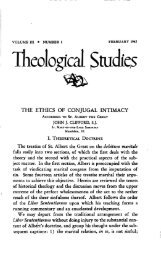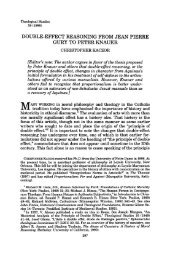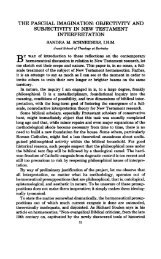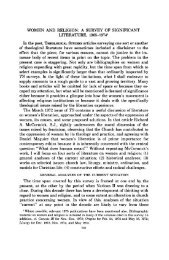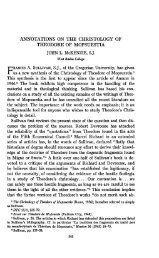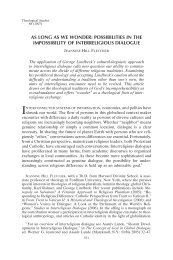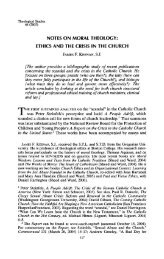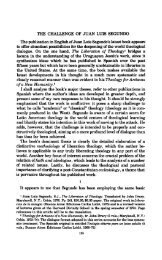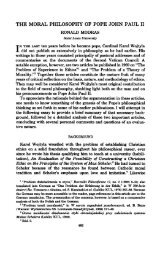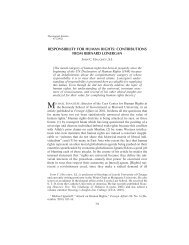SYMBOL, MYTH, AND THE BIBLICAL REVELATION AVERY ...
SYMBOL, MYTH, AND THE BIBLICAL REVELATION AVERY ...
SYMBOL, MYTH, AND THE BIBLICAL REVELATION AVERY ...
You also want an ePaper? Increase the reach of your titles
YUMPU automatically turns print PDFs into web optimized ePapers that Google loves.
4 <strong>THE</strong>OLOGICAL STUDIES<br />
overtones, magnificently brought out by the figurative and hyperbolic<br />
language of the inspired accounts. Viewed in connection with their New<br />
Testament fulfilment, these events take on a fuller and more abiding<br />
significance.<br />
In the New Testament the Incarnate Word is the absolute, unsurpassable<br />
earthly embodiment of God, and hence the supreme religious<br />
symbol. But for Christ to be effectively a symbol for us, He must be<br />
manifested for what He is. Jesus' mighty deeds, His symbolic actions<br />
(such as the cleansing of the Temple or the Eucharistic action at the<br />
Last Supper), His total self-oblation on Calvary, and God's acceptance<br />
of that sacrifice in the Resurrection and Ascension—all these events<br />
symbolically disclose various aspects of His person and mission. In<br />
Christ and the Church the religious symbolism of the Old Testament<br />
was "recapitulated"—in the rich sense given to the term by Irenaeus—and<br />
fulfilled beyond all expectation.<br />
If we wish to fathom the true nature of symbol, we could not do<br />
better than to ponder a central Christian reality, such as the Cross.<br />
Here, in a simple and easily imagined figure, we have a vast wealth of<br />
meaning that speaks straight to the human heart. The Cross, as<br />
Susanne Langer has pointed out, evokes a whole gamut of related<br />
significances:<br />
Many symbols—not only words, but other forms—may be said to be "charged"<br />
with meanings. They have many symbolic and signific functions, and these functions<br />
have been integrated into a complex so that they are all apt to be sympathetically<br />
invoked with any chosen one. The cross is such a "charged" symbol: the<br />
actual instrument of Chrises death, hence a symbol of suffering; first laid on his<br />
shoulders, an actual burden, as well as an actual product of human handiwork,<br />
and on both grounds a symbol of his accepted moral burden; also an ancient symbol<br />
of the four zodiac points, with a cosmic connotation; a "natural" symbol of<br />
cross-roads (we still use it on our highways as a warning before an intersection), and<br />
therefore of decision, crisis, choice; also of being crossed, i.e. of frustration, adversity,<br />
fate; and finally, to the artistic eye a cross is the figure of a man. All these and<br />
many other meanings lie dormant in that simple, familiar, significant shape. No<br />
wonder that it is a magical form! It is charged with meanings, all human and emotional<br />
and vaguely cosmic, so that they have become integrated into a connotation<br />
of the whole religious drama—sin, suffering, and redemption... . 4<br />
For reasons such as these, the Cross performs in an eminent way<br />
what all symbolism tends to do: it binds up the shattered, alienated<br />
4 Susanne K. Langer, Philosophy in a New Key (Cambridge, Mass., 1942) pp. 284 f.


